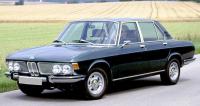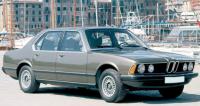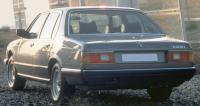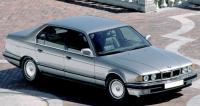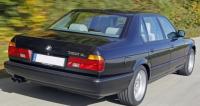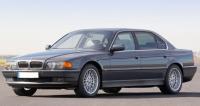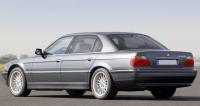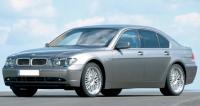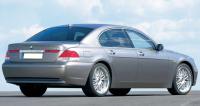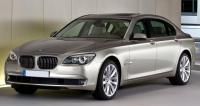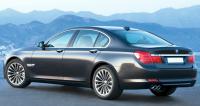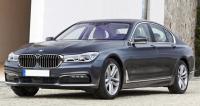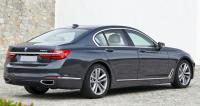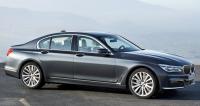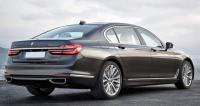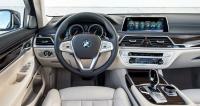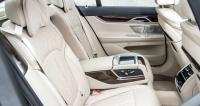The first two generations were equipped only with gasoline engines, and since 1995 they began to be equipped with diesel engines. IN difference from 3 Series and 5 Series this model was not produced with an index «M» (motorsport). The main competitors are Mercedes-Benz S-Class, Audi A8, Lexus LS and Jaguar XJ. For the period from 1997 to 2016, about 1 million cars were produced.
First generation (E23; 1977–1986)
In 1977, production of the first generation of the 7 Series began. This is a front-engined sedan with rear-wheel drive. The car had a variety of electronic components, such as an on-board computer, a service indicator, warning lights, a voice recorder, and sophisticated climate control. This is the first BMW car to use an anti-lock braking system (ABS) and driver's airbag.
All models were equipped with six-cylinder gasoline engines, with most engines being fuel injected, but the 728 and 730 models (1978-1979) used Solex carburetors. Fuel injected models until 1979 used the Bosch L-Jectronic system and then began to use the Bosch Motronic fuel injection system. Engine volumes were from 2.5 to 4.5 liters and power from 148 to 286 hp. Gearboxes were available mechanical with five and four gears and automatic three- or four-speed.
Second generation (E32; 1986–1994)
In September 1986, the second generation of the 7 Series appeared. The appearance of the car is attributed to the then head stylists Erkol Spada and Hans Kerschbaum. Design work began in late 1979, and by 1983 a 1:1 scale model was presented. The engine is located at the front with rear wheel drive. In total, about 300 thousand cars were built.
The 7 series is packed with modern options in the automotive industry at the time. These are built-in telephones, refrigerators, power seats, xenon headlights, active suspension, double glazing, CAN bus, climate control and much more.
At first, only 6-cylinder in-line gasoline engines were available (3.0 and 3.5 liters, 185 and 208 hp) and 12-cylinder V-shaped (5.0 liters, 295 hp). In 1992, 8-cylinder V8 engines appeared (3.0 and 4.0 liters, 215 and 282 hp). All engines are fuel injected. Gearboxes 4 and 5-speed automatic or 5-speed manual.
Third generation (E38; 1994–2001)
In early 1988, development began on the third generation of the 7 Series. The exterior was designed by Boyke Boyer. Production of prototypes began on July 23, 1993, and mass production began on February 17, 1994. The location of the engine and the drive is unchanged - front and rear wheels. This is the first car to use curtain airbags. traditional machine «stuffed» new at that time electronics and options. In total, about 340 thousand cars were produced.
The line of gasoline engines is a 6-cylinder in-line engine with a volume of 2.8 liters with a capacity of 190 hp, five 8-cylinder V8s with a volume of 3.0 to 4.0 liters with a capacity of 215 to 282 hp, and also a 12-cylinder V12 with a volume of 5.0 liters and a capacity of 322 hp. For the first time, diesel engines began to be installed on a car - two 6-cylinder in-line engines with a volume of 2.5 and 3.0 liters with a capacity of 141 and 190 hp. 8-cylinder V8 with a volume of 4.0 liters and a capacity of 241 hp
A 5-speed ZF 5HP automatic transmission was available on all models, and a 5-speed or 6-speed manual could also be ordered.
Fourth generation (E65, E66, E67, E68; 2001–2008)
Development began in early 1996. At the beginning of 1997, Chris Bangle gave a brief information about the vision of the future car of DesignworksUSA studio, and after a competition between 20 designers, in the spring of 1998, the project of Adrian van Hooydonk was approved. In September 2001, the car was presented at the Frankfurt International Motor Show. Over the entire period, about 330 thousand cars were produced.
It was the first BMW to feature iDrive, active anti-roll bars, a 6-speed automatic transmission, electronic smart key and night vision. Variety of body styles includes sedan (E65), extended sedan (E66), armored sedan (E67) and a hydrogen-powered sedan (E68). Front engine with rear wheel drive.
The range of engines remained almost unchanged. Gasoline engines 6-cylinder in-line with a volume of 3.0 liters with a capacity of 228 and 255 hp, 8-cylinder V8 with a volume of 3.5, 4.0, 4.5 and 5.0 liters with a capacity of 268, 302, 329 and 362 hp, as well as one 12-cylinder V12 with a volume of 6.0 liters and a capacity of 439 hp. Diesel engines with a volume of 3.0 liters with a capacity of 215 and 228 hp, a volume of 4.0 liters with a capacity of 259 hp. and a volume of 4.5 liters with a capacity of 295 and 322 hp.
Fifth generation (F01, F02, F03, F04; 2008–2015)
The exterior of the car was designed by Karim Habib. It was first shown on Red Square in Moscow on July 8, 2008. The car was further shown at the Paris Auto Show in October and the Los Angeles International Auto Show in November. In addition to the traditional rear-wheel drive, an xDrive all-wheel drive option has become available. Also, for the first time, a rear wheel steering system was used.
Body numbering was as follows - sedan (F01), long wheelbase sedan (F02), armored sedan (F03) and hybrid sedan (F04). The car used almost all modern options and technologies from the automotive world - pedestrian recognition for night vision, a blind spot monitor, adaptive cruise control, video cameras, two-stage brake lights and other security and driver assistance systems.
Gasoline engines were 6-cylinder in-line engines with a volume of 3.0 and 4.0 liters with a capacity of 255, 322 and 315 hp, 8-cylinder V8 with a volume of 5.0 liters with a capacity of 402 and 443 hp. and a 6.0-liter 12-cylinder with a capacity of 536 hp. Also two hybrid models with l6 and V8 engines. There are five diesel engines - all 6-cylinder in-line, with a volume of 3.0, 4.0 and 5.0 liters with a capacity of 241, 255, 302, 308 and 375 hp, all turbocharged. There are four transmissions to choose from - two 6-speed automatic (ZF 6HP19 and ZF 6HP26) and two 8-speed automatic (ZF 8HP70 and ZF 8HP90).
Sixth generation (G11, G12; 2015–present time)
The show of the new BMW 7 Series took place at the International Automobile Exhibition September 17-27, 2015 in Frankfurt am Main. Production began in July 2015 and sales began in October 2015. G11 is the code name for a regular wheelbase sedan, while G12 is a long wheelbase sedan, which is denoted by an additional letter L. Due to the use of composite materials, weight has been slightly reduced.
The sixth generation of the 7 Series incorporates almost every modern automotive technology, such as the iDrive system with gesture recognition, radar sensors, cruise control, driver warning systems, road marking recognition, laser headlights as an option, and much more. The front panel is equipped with lattice shutters to control the aerodynamic drag, which is 0.24.
Gasoline engines offered l4 (2.0 liter, 255 hp, turbo), l6 (3.0 liters, 322 hp, turbo), V8 (4.4 liters, 443 hp, turbo) and V12 (6.6 liters, 601 hp, turbo). As well as hybrid cars with 4-cylinder petrol engines of 2.0 liters and a total power of 322 hp. There are three diesel engines - all with a volume of 3.0 liters with a capacity of 261, 315 and 394 hp. Transmission on all cars is automatic 8-speed ZF Steptronic.

